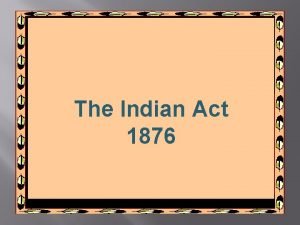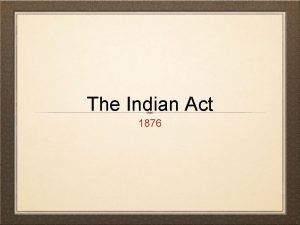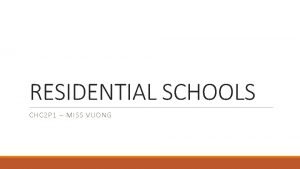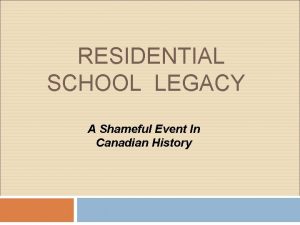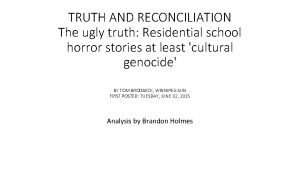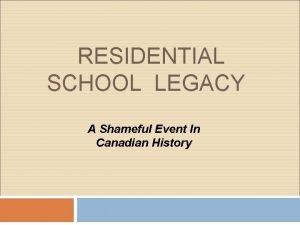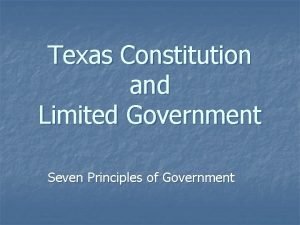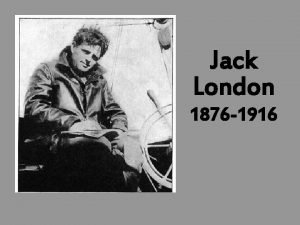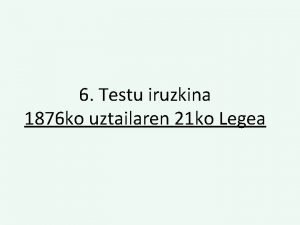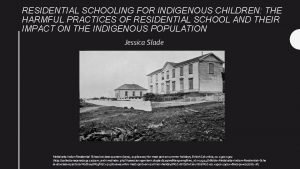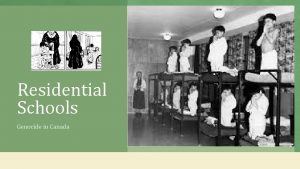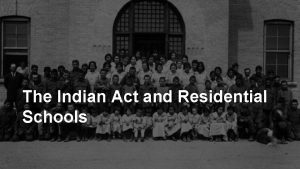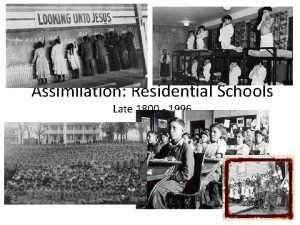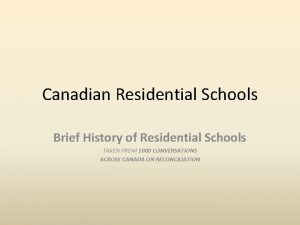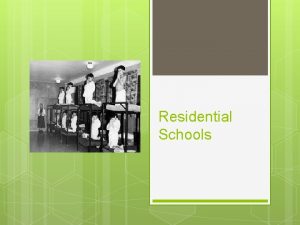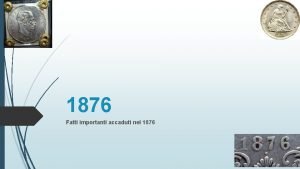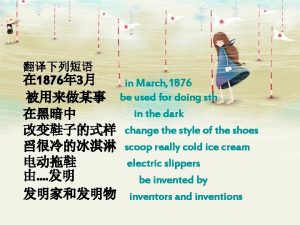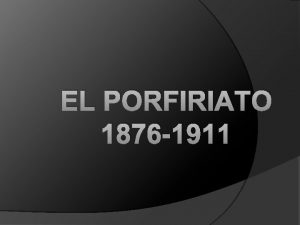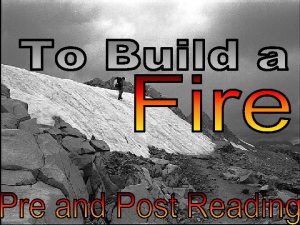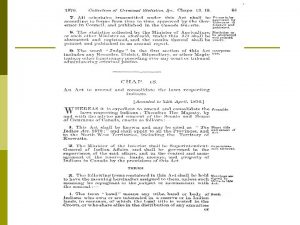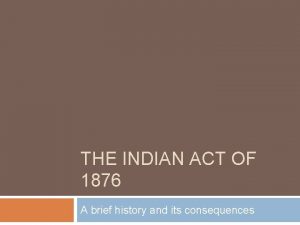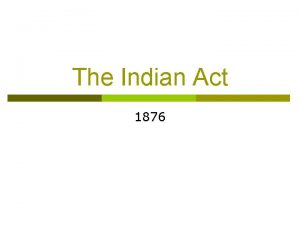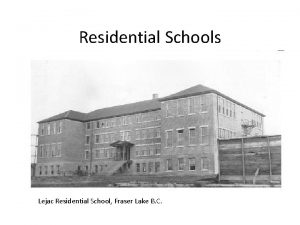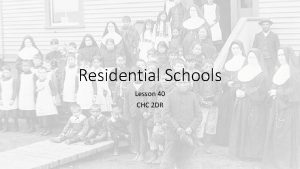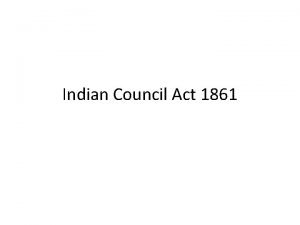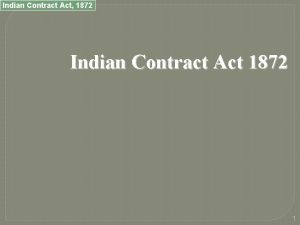The Indian Act Residential Schools Indian Act 1876
































- Slides: 32

The Indian Act & Residential Schools

Indian Act 1876 Gave legal power to the government to control the lives of First Nations. It included clauses about: 1. Indian Status 2. Land 3. Local Government

Indian Act The great aim of our legislation has been to do away with the tribal system and assimilate the Indian people in all respects with the other inhabitants of the Dominion as speedily as they are fit to change, " stated John A. Macdonald, in 1887. "

Indian Act – Indian Status It defined who could be an “Status Indian” �Wards of the government �Before 1951, Status Indians were not ‘people’ under the laws of Canada. �“people” if they relinquished Indian Status. �They could then vote, own property or have rights of other citizens.

Indian Act - Land �Reserve land was set aside for the use of status Indians. �Specified who could live on the Reserves.

Indian Act - Government �Local government modelled on Euro. Canadian town councils / ignored traditional First Nations forms of governing. �Traditional government – leadership was hereditary �Band councils - elected

Pass System �Another feature of the reserve system was that First Nations people on many reserves, especially in the prairies, had to get permission from a Government official, an “Indian Agent”, in order to leave the reserve. This was known as the “Pass System”. In some places this practice didn’t end until the 1960 s.

The Indian Act was imposed on First Nations and they had NO SAY whatsoever.

Residential Schools

Who established the residential school system in Canada? The Canadian Gov’t: � John A. Macdonald (Prime Minister) � Duncan Campbell Scott (Deputy Superintendent of Indian Affairs)

1876 & 1883 �In 1876, Indian Act placed residential schools under the jurisdiction of the Federal government �In 1883, John A. Macdonald, the Prime Minister, passed a cabinet measure to create three residential schools in the West to be operated by the Catholic and Anglican churches.

�Public Works Minister Hector Langevin said: “In order to educate the children properly we must separate them from their families. Some may say this is hard but if we want to civilize them we must do that”

In 1883, John A. Macdonald also said: “When the school is on the reserve, the child lives with his parents who are savages; he is surrounded by savages, and though he may learn to read and write, his habits and training and mode of thought are Indian. He is simply a savage who can read and write. ”

1920 �Law – All First Nations children had to attend Residential school if there was no day school near their home �In 1920, Duncan Campbell Scott amended the Indian Act making it mandatory for all First Nations children to attend residential school, knowing that the mortality rates ranged from 30% - 75%.

Assimilation �What is assimilation? An attempt to absorb Indigenous peoples into the dominant Euro-Canadian culture.

How were residential schools used to accomplish the goal of assimilation? Children were forced to adopt the dominant culture’s: � Language � Physical � Cultural appearance practices � Religious views * Removing children from their families made this process easier – the longer they were away from home, the less influence their family and community had on their upbringing

Quote from 1920 � “Our objective is to continue until there is not a single Indian in Canada that has not been absorbed into the body politic, and there is no Indian question and no Indian department. ” …Duncan Campbell Scott

Why did First Nations children go? �It was the law �Indian agents on the reserve would withhold food and benefits from those who did not go �Children �Parents were forcibly taken could face jail time if they refused to let their children go

What was the predominant attitude of non. Indigenous Canadians toward the government’s assimilation policy? �Questions to consider: • What message is being given through the video and the photos? • What does the government want the public to believe about residential schools?



�CBC Digital Archives – link

�Questions to consider: • What message is being given through the video and the photos? • What does the government want the public to believe about residential schools?

Where were residential schools located?

Where were residential schools located? �BC – link

Who ran residential schools? �For most of their existence, churches of the Christian faith ran residential schools. �Most schools were run by: �Catholic Church �Anglican Church �United Church �Presbyterian Church

Priests and Nuns taught the children


Why involve the churches? 1) It was cheaper for the government than hiring qualified school teachers and running the facilities themselves 2) Churches took a keen interest in assimilating Indigenous people into the dominant Euro-Canadian culture/religion – saw it as their religious duty.

How long did residential schools operate in Canada? � In 1969, the partnership between the gov’t and churches ended, and the federal government took over the Residential School System. �The Government of Canada oversaw residential schools from 1883 until the last federally run school closed in 1996.

Stations Note-Making �Go to our class website, to “Residential Schools” – scroll down to ACTIVITY 4, work through the “Stations” and links on to gather more notes for the following : 1) 2) 3) How children spent their time. Immediate impacts Long term impacts

Impacts of Residential Schools �“The impacts of the legacy of residential schools have not ended with those who attended the schools. They affected the Survivors’ partners, their children, their grandchildren, their extended families, and their communities. ”
 Indian act 1876
Indian act 1876 Indian act 1876
Indian act 1876 Residential schools canada
Residential schools canada Residential schools in canada map
Residential schools in canada map Residential schools horror stories
Residential schools horror stories Before and after residential schools
Before and after residential schools Residential schools
Residential schools Residential schools in saskatchewan map
Residential schools in saskatchewan map Thomas moore residential schools
Thomas moore residential schools Dewey decimal system 500-599
Dewey decimal system 500-599 Clay tablets pre industrial age
Clay tablets pre industrial age Texas constitution of 1876
Texas constitution of 1876 Jack london (1876-1916)
Jack london (1876-1916) Re denley
Re denley 6. testu iruzkina
6. testu iruzkina Metlakatla residential school
Metlakatla residential school Huntsville city schools powerschool
Huntsville city schools powerschool Reach schools safety schools and
Reach schools safety schools and Indian boarding school the runaways
Indian boarding school the runaways Addressing bullying in schools act
Addressing bullying in schools act Admissions to schools act 2018
Admissions to schools act 2018 Cái miệng bé xinh thế chỉ nói điều hay thôi
Cái miệng bé xinh thế chỉ nói điều hay thôi Mật thư tọa độ 5x5
Mật thư tọa độ 5x5 Bổ thể
Bổ thể Tư thế ngồi viết
Tư thế ngồi viết Thẻ vin
Thẻ vin V cc
V cc Thể thơ truyền thống
Thể thơ truyền thống Hát lên người ơi alleluia
Hát lên người ơi alleluia Các châu lục và đại dương trên thế giới
Các châu lục và đại dương trên thế giới Hươu thường đẻ mỗi lứa mấy con
Hươu thường đẻ mỗi lứa mấy con Từ ngữ thể hiện lòng nhân hậu
Từ ngữ thể hiện lòng nhân hậu Diễn thế sinh thái là
Diễn thế sinh thái là
